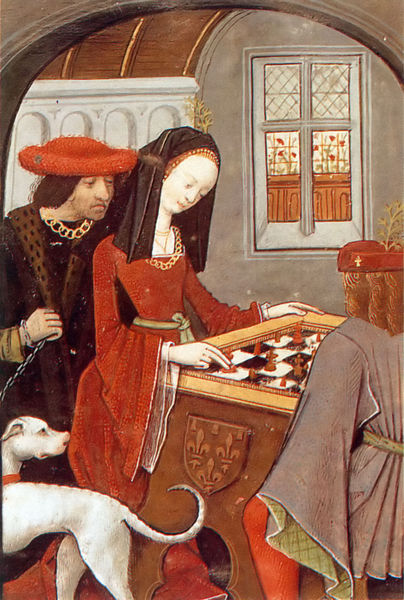Although I write novels set in sixteenth century France, the novel, as a genre, was unknown during this period. The Middle Ages had witnessed the flowering of narrative poetry--epics like the
Chanson de Roland or
Les quatre fils Aymon, romances like Chrétien de Troyes's
Yvain ou le Chevalier au lion--and the development of the historical chronicle, such as those of Froissart, but the form of the novel--a long fictional work of prose depicting characters, settings, and events imagined by the author--would not develop until the seventeenth century.
Of cour

se, people have always told stories, especially in pre-literate times when individuals would gather and tell tales to entertain themselves. During the Renaissance, humanist scholars began to transcribe such tales, often setting them in a mimetic framework. A prime example, which served as the model for countless other works, is Boccaccio's
Decameron, composed in the early 1350's in the Italian vernacular. The frame story of the
Decameron depicts ten young people taking refuge in the Italian countryside from the plague; each day, for ten days, the characters each recount a tale to while away the hours. The first example of such a structure in French is
Les Cent nouvelles nouvelles, or "One Hundred New Tales" compiled by Antoine de la Sale around 1456 at the court of Philippe le Bon. Numerous noblemen contributed tales to the collection, although many are borrowed directly from Boccaccio and other Italian
conteurs. These often bawdy tales give tantalizing glimpses into the lives of fifteenth-century noble and middle classes.
While the
Cent nouvelles nouvelles lacks a frame story, the importance of the mimetic context grew during the sixteenth century. At mid-century, Noël du Fail, a rural aristocrat from Brittany, penned three collections of tales,
Les Propos rustiques (1547),
Les Baliverneries d'Eutrapel (1548) and the
Contes et propos d'Eutrapel (1585). In these works, the frame story depicts in realistic detail the social milieu of the rural peasantry as well as that of the upper classes. Du Fail focuses on the linguistic habits of each group; his tales have been called "
dialogue tales" because they strive to recreate the speech patterns of each social group in a conversational way. In their expanding situational context and attention to realistic detail, Du Fail's tales prefigure the larger narrative and pyschological scope of the novel.

Of course, the most well-known of the French tale collections is that of Marguerite de Navarre,
L'Heptaméron, published posthumously in 1558, although it had circulated in manuscript form for years. In this collection of seventy-two tales, the interplay between the tales and the tellers is critical. Following Boccaccio's lead, Marguerite strands a group of travelers in an abbey during a torrential storm; each day, the members of the group tell tales to pass the time until the bridge is rebuilt. However, in Marguerite's collection, the characters' commentary on the tales and the relationships that blossom during the conversations that link the tales together became just as, if not more, important than the tales themselves. Marguerite develops a distinct personality for each of her tellers and manipulates their interaction with great psychological insight. Her attention to the psychology of the characters heralds the birth of the novel, which is traditionally attributed, in the French tradition, to Madame de Lafayette's
La Princesse de Clèves (1678), a novel set, ironically, in the sixteenth century at the end of the reign of Henri II.
I love the fact that the first French novel is an historical one.
 Just want to point out that my friend Sheramy Bundrick's novel about Vincent Van Gogh, SUNFLOWERS (Avon A, October 2009), received a starred review from Publisher's Weekly! Sheramy gave me an ARC of the book and I was completely drawn into this story of Vincent's years in Provence, told from the viewpoint of Rachel, the prostitute to whom he presented his ear. I'll post a review and hopefully an interview with Sheramy closer to the release date. In the meantime, mark your calendars for October 13.
Just want to point out that my friend Sheramy Bundrick's novel about Vincent Van Gogh, SUNFLOWERS (Avon A, October 2009), received a starred review from Publisher's Weekly! Sheramy gave me an ARC of the book and I was completely drawn into this story of Vincent's years in Provence, told from the viewpoint of Rachel, the prostitute to whom he presented his ear. I'll post a review and hopefully an interview with Sheramy closer to the release date. In the meantime, mark your calendars for October 13. se, people have always told stories, especially in pre-literate times when individuals would gather and tell tales to entertain themselves. During the Renaissance, humanist scholars began to transcribe such tales, often setting them in a mimetic framework. A prime example, which served as the model for countless other works, is Boccaccio's
se, people have always told stories, especially in pre-literate times when individuals would gather and tell tales to entertain themselves. During the Renaissance, humanist scholars began to transcribe such tales, often setting them in a mimetic framework. A prime example, which served as the model for countless other works, is Boccaccio's  Of course, the most well-known of the French tale collections is that of Marguerite de Navarre,
Of course, the most well-known of the French tale collections is that of Marguerite de Navarre, 












